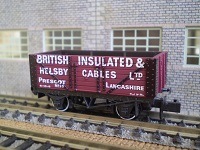The railways were born in the Industrial Revolution of the early nineteenth century, harnessing cutting-age
technology to bring the age-old dream of rapid transport into reality. They served industries old and new, and one of the newest
and most high-tech industries of the Victorian era was based on the new-found scientific understanding of electricity. It turned
out that this mysterious force of nature could be tamed and harnessed, and used to power all kinds of clever devices and
machines. And cleverest of all was the electric telegraph, which could transmit messages along metal wires in an instant.
Making metal cables became big business, and one of the pioneers in the UK was the British Insulated Wire Company with their
ground-breaking engineer Sebastian de Ferranti. They set up shop in 1890 in the Lancashire town of Prescot, on the LNWR's line
from Liverpool to Wigan, and built a factory just across the road from the railway station. Business boomed, and in 1902 they
merged with the Telegraph Manufacturing Company from Helsby, a few miles away on the other side of the River Mersey. The new
venture was given the snappy title of British Insulated & Helsby Cables, and over the next few decades it went from strength
to strength. By the mid-1920s the Prescot factory employed 4,000 men, and their cables were exported all over the world. The
factory boilers and smelters would have needed prodigious quantities of coal to keep them blazing away, and the company brought
it from pit to furnace in a fleet of smart maroon wagons with their name writ large on the side.
The good times couldn't last, however, and in 1945 the company merged with Callenders Cables of Kent to form BICC. The Prescot
factory, once the biggest cable works in the world, closed in 2006, and BICC themselves are no more. But you can bring back the
heyday of the cable industry on your layout with our British Insulated & Helsby Cables wagon.
Please note that a wagon load is not included.
To buy this wagon along with our Poynton Collieries wagon, please go to our 'N' Sets page.
|









